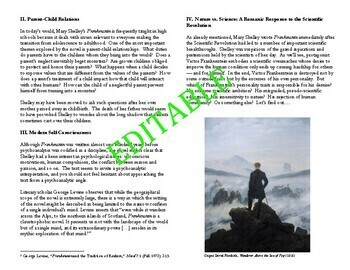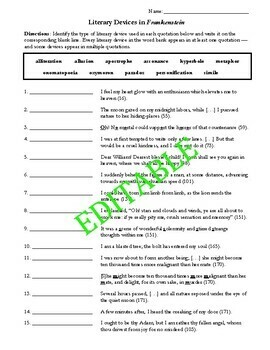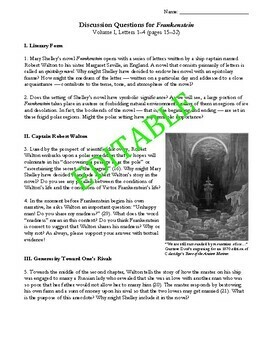Frankenstein COMPLETE UNIT | Discussion Questions, Quizzes, & Writing | EDITABLE
- Zip
What educators are saying
Description
Rigorous! Thought-provoking! Discussion-based!
This 100-page EDITABLE curriculum has everything you'll need for profoundly stimulating lessons on Mary Shelley's Frankenstein! Invite your class to engage in student-driven discussions without compromising on intellectual rigor. The pre-reading handouts, discussion questions, daily quizzes, and analytical writing assignments will challenge your students to dig beneath the surface of the text and generate profound interpretive insights!
This unit was designed to have more than enough rigor for Honors, IB, and AP courses. Hold your students accountable for completing the nightly homework by beginning every class with a quick vocab and reading quiz. Facilitate dynamic discussions that motivate students to become attached to the thrill generating shared knowledge. Challenge students to explicate textual details using a wide range of interpretive lenses: historicist, psychoanalytic, feminist, etc. Inspire students to arrive at a whole new depth of insight!
Here are some highlights from the curriculum:
• Biographical Sketch of Mary Shelley (Pre-Reading Handout): Mary Shelley's mother was the most important feminist political philosopher of the 18th century: Mary Wollstonecraft. But when Wollstonecraft gave birth to Mary Shelley, she became infected with sepsis and died shortly thereafter. Is it any accident that Mary Shelley would write a novel about a protagonist who is repulsed by his own offspring? To what extent did Shelley perceive herself as a kind of monster? These and many other questions get students thinking about the relation between Mary Shelley's turbulent life and her literary masterpiece. (2 pages)
• Themes in Frankenstein (Pre-Reading Handout): Because the full title of Shelley's novel is Frankenstein; or, The Modern Prometheus, this handout introduces students to the Prometheus myth and challenges students to ponder how Shelley might have sought to update or rewrite the myth for the modern era. What happens when humans develop technologies — like Prometheus's act of stealing fire — that should remain the rightful provenance of nature? Should characters like Prometheus and Frankenstein be admired as rebellious heroes? Or should they be despised as an arrogant overreachers? Get students thinking before they even crack the cover of Shelley's novel! (2 pages)
• Discussion Question Handouts: Thirty pages of higher-order discussion questions guaranteed to inspire profoundly thoughtful class discussions! This unit features double-sided handouts with 8-10 questions for each of the novel's 10 sections. The discussion questions are the beating heart of these lesson plans. They challenge students to build interpretive arguments that require the support of carefully selected textual evidence — leading to keen interpretive insights! (30 pages)
• Vocabulary Lists: Lists of 10 vocabulary words for every reading assignment, complete with definitions and sample sentences with the words as used in Frankenstein. A total of 100 words. (10 pages)
• Vocabulary & Reading Quizzes: Quizzes with 10 questions per reading assignment. Build students’ vocabularies while holding them accountable for the nightly reading homework. Each quiz contains roughly 7 questions on vocabulary words plus another 3 questions on reading comprehension. Grading these quizzes is simple and quick. They’re an easy way to log 10 more grades in your gradebook. Answer keys included. (20 pages)
• Literary Devices Worksheet: This worksheet challenges students to identify the literary devices used in fifteen quotations from Frankenstein. The literary devices include metaphor, simile, personification, hyperbole, oxymoron, allusion, onomatopoeia, and more. This bundle also features a glossary with definitions of the literary devices as well as examples of how each device is used in Shelley's novel — so you can review the devices with students before they tackle the worksheet. The worksheet can be used either as a quiz or as a fun refresher. Answer key included. (3 pages)
• Quotation Race: Students work in pairs to identify the speakers of 25 key quotations from Frankenstein. Introduce this fun activity when you need to mix things up, or to refresh students' memories in preparation for the AP exam. Answer key included. (4 pages)
• Q3 Practice Essay: Designed for AP Lit teachers, this in-class practice essay will allow students to rehearse the "Q3" essay from the AP Literature and Composition Exam. The assignment asks students to choose from among three recent Q3 prompts that featured Frankenstein as one of the recommended works of literary merit. (5 pages)
• Analytical Writing Assignment: Challenge students to take their interpretations one step further by writing an analytical paper on Mary Shelley's wonderfully complex novel. Let students choose from one of eight profoundly thought-provoking sample topics — or invite them to develop a similar topic of their own. Rubric included. (5 pages)
My store is called “Rigorous Resources” because all of the units feature rigorous, content-rich lessons guaranteed to boost your students' close-reading and critical-thinking skills. At the same time, these lessons are filled with dozens of historically relevant visual images — facsimiles of Shelley's handwritten manuscript drafts, woodcuts and illustrations from early editions of the novel, newspaper clippings from the Enlightenment period, portraits of Mary and Percy Shelley — that shed light on the sources and scenes of Mary Shelley's Frankenstein. But what really distinguishes this unit is how the pre-reading handouts, discussion questions, and writing assignment enable student arrive at an abundance of interpretive insights!!
This 100-page unit will come to you in two separate formats: Microsoft Word *and* PDF. Because the Word doc is editable, you'll be able to CUSTOMIZE the materials to suit your teaching style and/or your students' skill levels — year after year! If you don't have Microsoft Word, you'll still be able to access the full unit in PDF format — which is easy to navigate and quick to print!
Finally, I believe that teachers should be able to see what they'll be getting before they purchase. So the preview for this resources on Frankenstein provides direct access to over 25 actual pages from the bundle. Click on the green “preview” button to see exactly what you’ll get....
Thank you for choosing “Rigorous Resources”!!
Happy teaching!
Adam Jernigan, Ph.D.
adamjernigan@gmail.com
P.S. Don't forget to click “follow” for email updates on new products by Rigorous Resources. New products will be 50% OFF for the first 24 hours!





